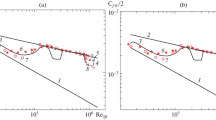Abstract
The characteristic features of the formulation of a two-layer turbulence model and its application in calculation of near-wall turbulent flows are considered. Factors that influence the effectiveness of implementation of the model and ways of expanding the limits of its applicability are discussed. The possibilities of the two-layer model are demonstrated by calculating a boundary layer on a flat plate with a longitudinal pressure gradient. A comparison of the results of calculation of the heat-transfer characteristics by the two-layer model, two-parameter dissipation model, and Spalart-Allmaras model with the data of a physical experiment and available correlations is made.
Similar content being viewed by others
References
E. P. A. Libby and F. A. Williams (Eds.), Turbulent Reacting Flows, Academic Press, New York (1994).
I. A. Belov and S. A. Isaev, Modeling of Turbulent Flows [in Russian], Izd. BGTU, St. Petersburg (2001).
P. R. Spalart and S. R. Allmaras, A one-equation turbulence model for aerodynamic flows, AIAA Paper, No. 92-0439 (1992).
S. Deck, P. Duveau, P. d’Espiney, and P. Guillen, Development and application of Spalart-Allmaras one-equation turbulence model to three-dimensional supersonic complex configurations, Aerospace Sci. Technol., 6, 171–183 (2002).
D. C. Wilcox, Dilatation-dissipation corrections for advanced turbulence models, AIAA J., 30, 2639–2646 (1992).
B. E. Launder and D. B. Spalding, The numerical computation of turbulent flows, Comp. Meth. Appl. Mech. Eng., 3, 269–289 (1974).
M. Kato and B. E. Launder, The modelling of turbulent flow around stationary and vibrating square cylinders, in: Proc. 9th Symp. on Turbulent Shear Flows, 16–18 August 1993, Kyoto, Japan (1993), Vol. 9, pp. 10.4.1–10.4.6.
M. A. Leschziner and W. Rodi, Calculation of annular and twin parallel jets using various discretization schemes and turbulent-model variations, ASME J. Fluid Eng., 103, 353–360 (1981).
J. Ch. Bonnin, T. Buchal, and W. Rodi, ERCOFTAC workshop on data bases and testing of calculation methods for turbulent flows, ERCOFTAC Bulletin, No. 28, 48–54 (1996).
M. Wolfshtein, The velocity and temperature distribution of one-dimensional flow with turbulence augmentation and pressure gradient, Int. J. Heat Mass Transfer, 12, 301–318 (1969).
L. N. Norris and W. C. Reynolds, Turbulent channel flow with a moving wavy boundary, Report of Stanford University, No. FM-10 (1975).
W. Rodi, Experience with two-layer models combining the k-ε model with one-equation model near a wall, AIAA Paper, No. 91-0216 (1991).
H. C. Chen and V. C. Patel, Near-wall turbulence models for complex flows including separation, AIAA J., 26, No. 6, 641–648 (1988).
W. Rodi, N. N. Mansour, and V. Michelassi, One-equation near-wall turbulence modeling with the aid of direct simulation data, J. Fluids Eng., 115, 196–205 (1993).
M. Jaeger and G. Dhatt, An extended k-ε finite element model, Int. J. Num. Meth. Fluids, 14, 1325–1345 (1992).
T. Jongen and Y. P. Marx, Design of an unconditionally stable, positive scheme for the k-ε and two-layer turbulence models, Computers Fluids, 26, No. 5, 469–485 (1997).
D. Guezengar, J. Francescatto, H. Guillard, and J.-P. Dussauge, Variations on a k-ε turbulence model for supersonic boundary layer computations, Eur. J. Mech. B/Fluids, 18, 713–738 (1999).
V. K. Garg, Heat transfer research on gas turbine airfoils at NASA GRC, Int. J. Heat Fluid Flow, 23, 109–136 (2002).
A. J. H. Teekaram, C. J. P. Forth, and T. V. Jones, Film cooling in the presence of mainstream pressure gradients, ASME J. Turbomachinery, 113, 484–492 (1991).
K. N. Volkov, Use of the control-volume method for solving problems of liquid and gas mechanics on unstructured grids, Vychisl. Metody Programmir., 6, No. 1, 43–60 (2005).
K. N. Volkov, Discretization of convective flows in the Navier-Stokes equations on the basis of high-resolution difference schemes, Vychisl. Metody Programmir., 5, No. 1, 129–145 (2004).
R. A. Seban and L. H. Back, Effectiveness and heat transfer for a turbulent boundary layer with tangential injection and variable freestream velocity, ASME J. Heat Transfer, 84, 229–238 (1973).
H. Hay, D. Lampard, and C. L. Saluja, Effects of the condition of the approach boundary layer and of mainstream pressure gradient on the heat transfer coefficient on film-cooled surfaces, ASME J. Eng. Gas Turbines Power, 107, 99–112 (1985).
W. M. Kays and M. E. Crawford, Convective Heat and Mass Transfer, McGraw-Hill, New York (1980).
Author information
Authors and Affiliations
Additional information
__________
Translated from Inzhenerno-Fizicheskii Zhurnal, Vol. 80, No. 1, pp. 90–99, January–February, 2007.
Rights and permissions
About this article
Cite this article
Volkov, K.N. Application of a two-layer model of turbulence in calculation of a boundary layer with a pressure gradient. J Eng Phys Thermophys 80, 97–106 (2007). https://doi.org/10.1007/s10891-007-0013-0
Received:
Issue Date:
DOI: https://doi.org/10.1007/s10891-007-0013-0



